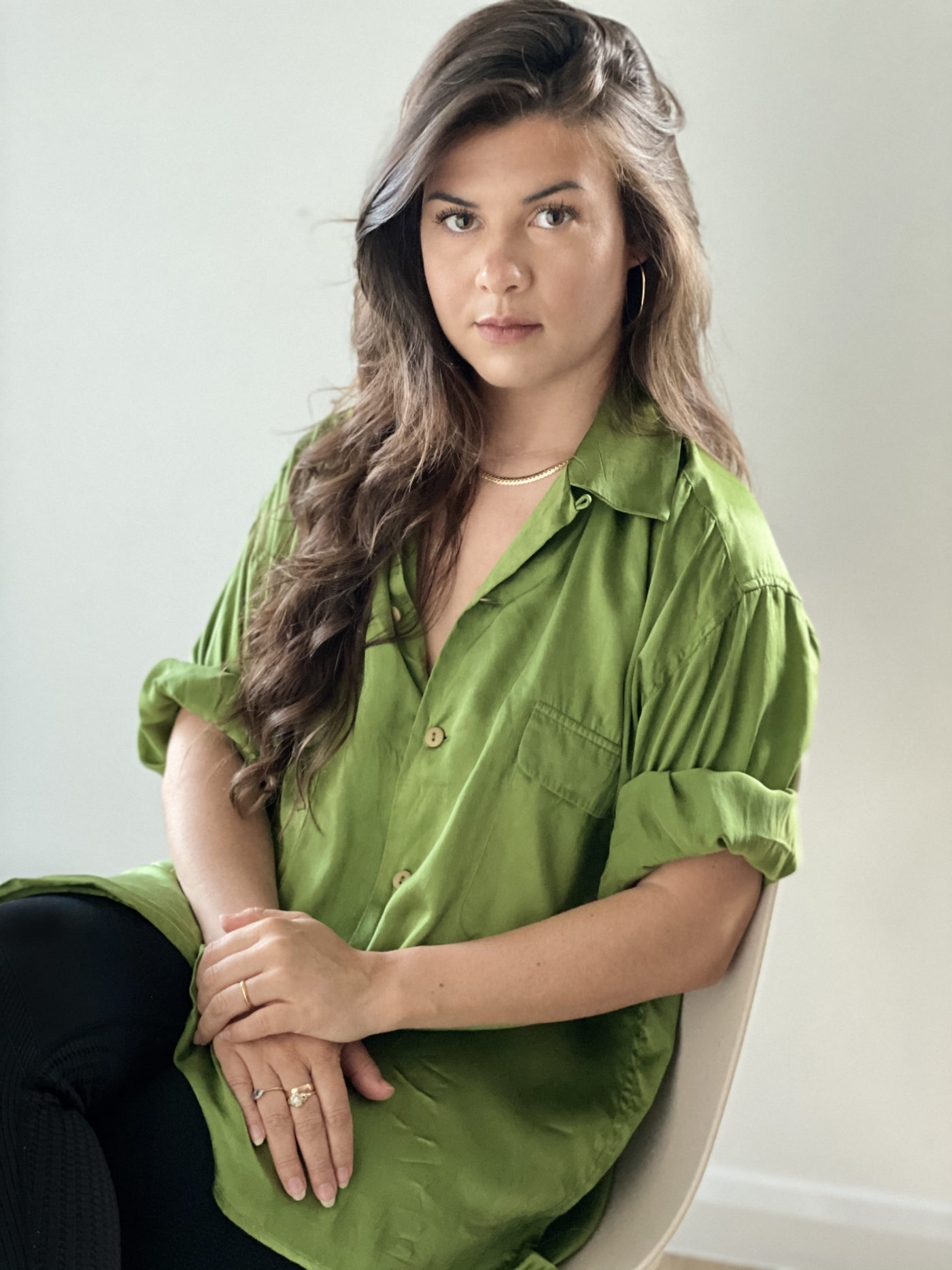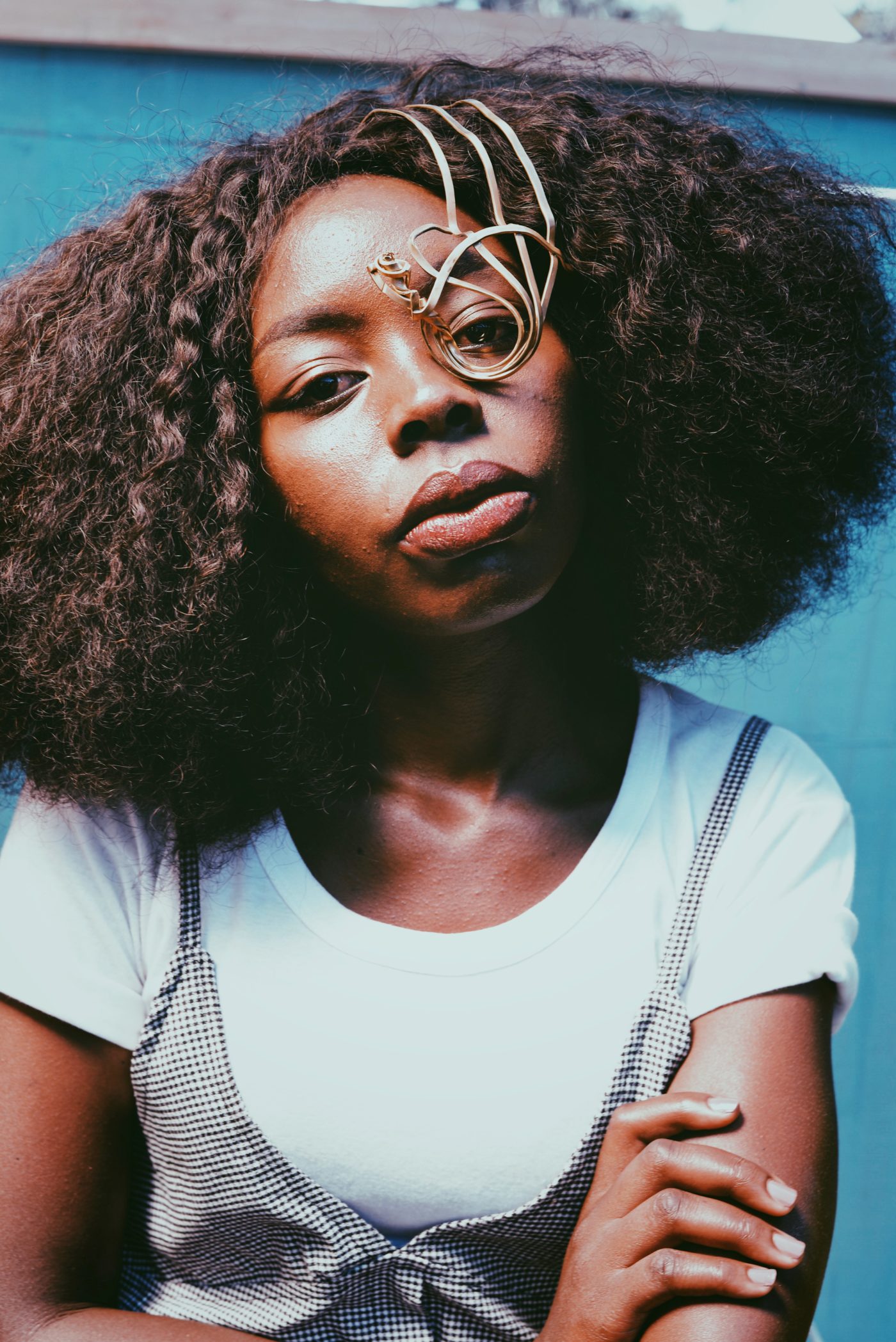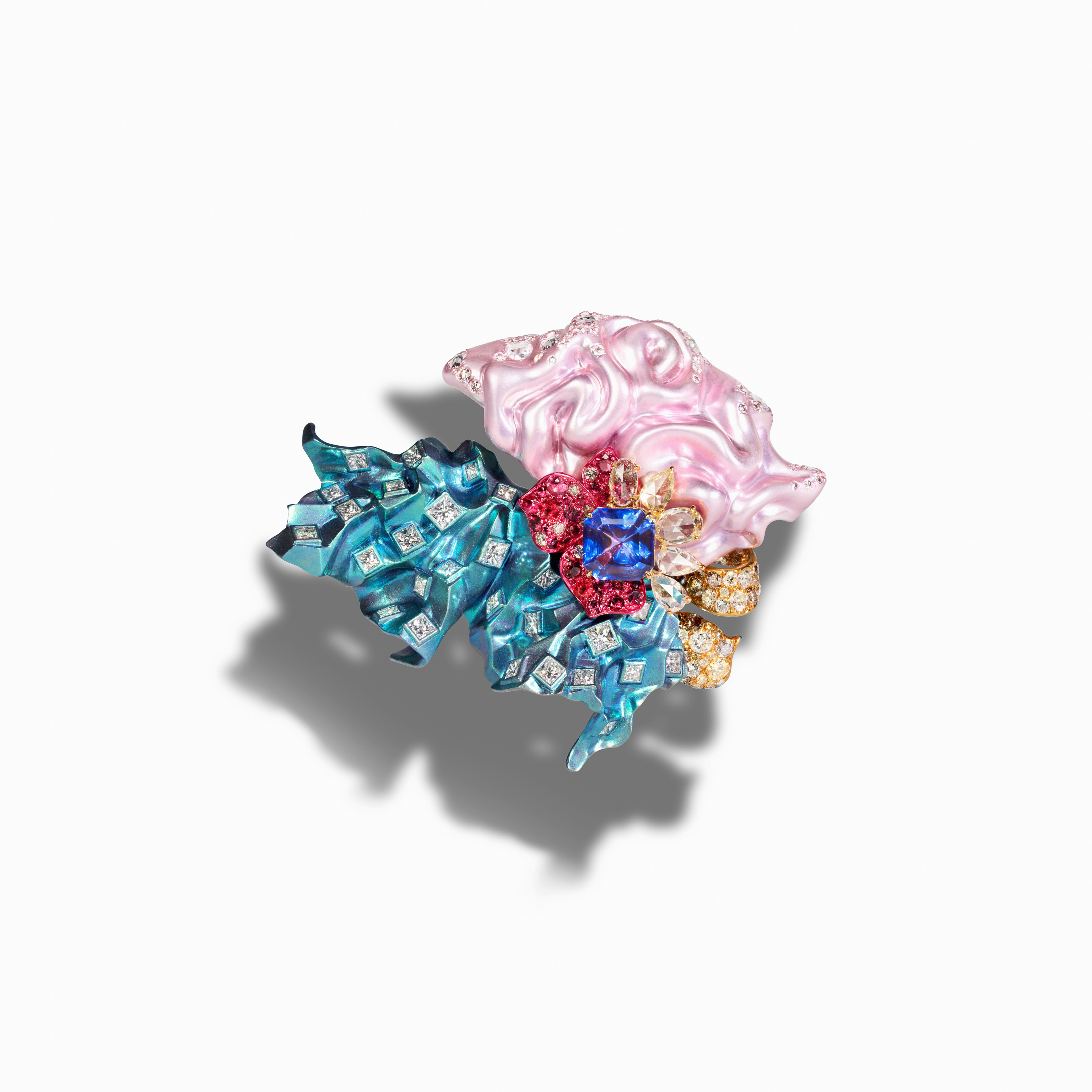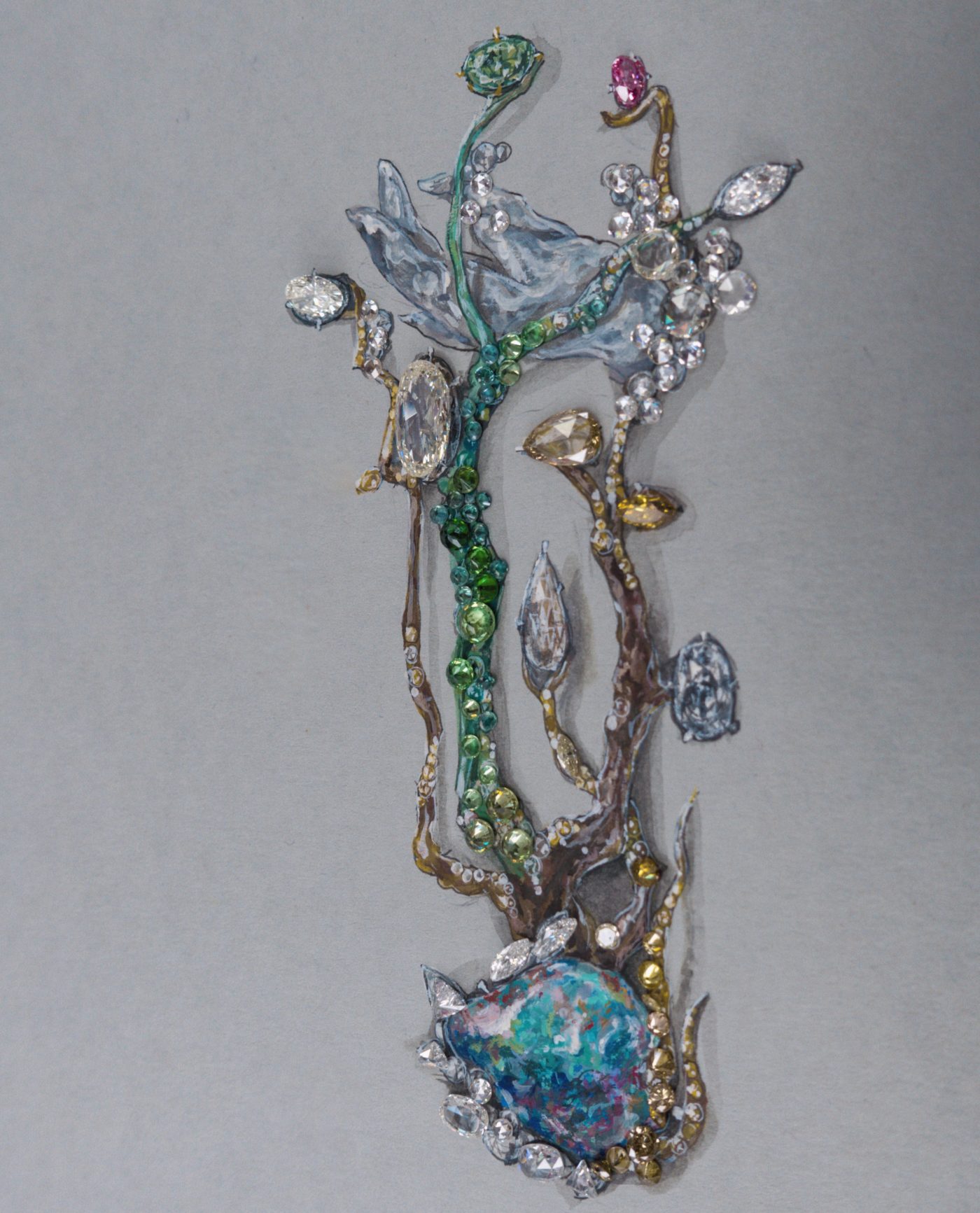Behind Exhibitionist: Interview with Curator Jodie Marie Smith
Yesterday, NYCJW Co-founder JB Jones spoke with Jodie Marie Smith, the curator of the current iteration of EXHIBITIONIST, on Instagram Live. Today, we’re sharing a special extended interview with Jodie.
Before we dive in, let’s start with a bit more about Exhibitionist, NYCJW’s online exhibition space. On the Exhibitionist platform, we ask six exceptional jewelers to respond to prompts about their practice and business that relate to their personal history and the ever-changing world around them. For its second iteration, we invited Jodie to curate which jewelers would be involved.

For those of you who aren’t familiar with Jodie Marie Smith, she is a San Francisco based writer, trend forecaster and creative consultant specialising in the jewellery and luxury industries. With a background in fine jewellery and having recently emigrated from London, Jodie has written for Current Obsession, The Future Lab, Rapaport, 1st Dibs, Adorn Insight, The Adventurine, Jewelry Connoisseur and The Jewellery Cut, amongst others. Her most recent series of articles explores digital jewellery – including NFTs, the metaverse, blockchain technology, digital fashion and dressing, and gen z consumer identities amongst other future-facing topics.
With that, let’s dive into the interview!
JB Jones: “Non Fungible Tokens (NFT’s) are to the 2020s what IT girls were to the 2000s: ubiquitous and securing online attention wherever their name is attached…” while this doesn’t directly pertain to jewelry,
(read Jodie’s article and see how it does on Current Obsession) I wanted to start with this because it’s about your approach.
You have a way of taking something that might seem out of reach, and creating an entry point for it for people who didn’t think they cared about NFT’s or in this case, jewelry. It’s within that space, too, that was where EXHIBITIONIST was born – an idea to create a space that is about accessibility and understanding – an entry point into the minds of visionaries in the field and an entry point into their work.
JB Jones for Future Heirloom: Why was it of interest to you to take on this curation?
Jodie Marie Smith: It was an absolute joy of a project to be part of! To ask jewelers to curate their own selections for an exhibition according to what specific designs mean to them is a really interesting way of showcasing their relationships to their creations. I feel like this format really gives the creators more control and ‘ownership’ in forming their own narrative. It was a big undertaking from each jeweler to provide us with so much information and to muse on the topics we asked about, so I want to extend my thanks to all of them again for that! Also, any opportunity to showcase the jewelers I love is genuinely exciting, I’m thrilled at the idea of people discovering jewelers they hadn’t encountered before or reading their interviews and giving a new perspective on a jeweler they may already be familiar with.


Future Heirloom: Can you give us a glimpse into your curatorial process? How (if at all) do you feel that your curatorial vision aligns with your interests and background in the jewelry industry?
JMS: My professional background is in fine / high jewellery, and I was living in London for most of my career, so any selection of jewellers I made would have to include high jewellers, (VRAM, Ming Lampson and Gearry Suen) and at least a couple of London based jewellers (Ming and Gearry.) Of the three fine jewellers in this exhibition, I have been a long term supporter of them, since the moment I was introduced to each one, I fell in love and have shouted about them as much as possible for a while.
My personal background is that I’m from a working class family in Northern England, with absolutely no connection to the jewellery world. I can’t pretend that this won’t have shaped my perspective on the jewellery industry, and particularly some of the outdated attitudes which are associated with traditional fine jewellers. Basically, I don’t think that high value materials necessarily have any bearing on what is or isn’t fine or high jewellery. Not all expensive jewellery is created equal! There are pieces which retail for millions which have had less thought put into them than pieces which retail for $500. Craftsmanship and technique – whether through extraordinary feats of talent, engineering, or simply imagination, are what make me gasp. All of this contributes to why this selection of jewelry had to be so diverse – and we also wanted to reflect and appeal to the spectrum of tastes of New York Jewelry Week’s audience!


FH: The jewelers you’ve chosen include a range of techniques and materials, and a mixture of fine and art jewelry approaches. Was that combination of approaches important to your curatorial vision?
JMS: Of course, as with every initiative NYCJW leads, we wanted to present as diverse a range of six jewellers as we possibly could. Last year, I came to NYCJW with the idea of a global trend panel, as I felt I was sick of hearing the Eurocentric / US market trends dominate every single conversation, as if there were no cultural or geographical nuance to the concept of ‘trends’ at all. Those echo chambers create redundant perspectives for global digital platforms. For Exhibitionist, I wanted to be true to my taste, and that in itself needs to be diverse in the work I do. If I only wrote about / shared / created content which focused on heritage European jewellery houses and ignored everything else going on in this industry, I’d be failing at saying anything new or at all relevant, in my opinion. This diversity doesn’t just mean gender, race, nationality, geography, but in artistic background, style, cultural influences, approaches, markets, taste. Essentially who their consumers are, who their audience is.
Curation is another overused term, but I believe it is a talent in itself that has value – when you place something alongside anything else, a monologue becomes a conversation, and each different element re-contextualises the other. I LOVE the idea of someone who is already a Gearry Suen fan finding the similarly colorful, maximalist joy of Claire Webb through this series, or vice versa. Punk influences are interpreted into jewellery by Chris Habana and Ming Lampson in completely different ways. Disciples of minimalism seeing the thread between forms which VRAM and Theresia Kyalo have sculpted.


FH: What led you to choose these six jewelers?
Jodie Marie Smith on Gearry Suen: Though based in London after studying at Central Saint Martins and the Royal College of Art, Gearry was born in China, and many elements of his aesthetic, his artistic practices, his philosophy, are intertwined with his heritage and background. I discovered Gearry early on, right as he graduated in 2020 and was lauded with accolades from The Goldsmiths’ Craft and Design Council Competition, the Goldsmiths Company Award and Theo Fennell’s Gilded Youth awards. My first reaction was non-stop talking to my husband about how amazingly talented this designer is and how important he was going to become, I knew everyone who saw the pieces and images I’d seen would be blown away. I think it’s so rare that a question of taste doesn’t come into a jewellers’ success, I find it hard to imagine anyone who’s ever cared about jewellery in any way wouldn’t agree that his jewellery is objectively mind-blowing. The experimental forms, the surreal references, the gemstone architecture – these are jewellery sculptures. There’s a lot of argument about categorisation in certain quarters of the industry – but no one could deny that Gearry Suen makes art jewellery – museum quality, investment pieces with the highest level of artistry and finish. I mean, they could try, but I’d fight them.


Jodie Marie Smith on Claire Webb: Claire Webb’s jewellery is a relatively recent obsession of mine, but when I say obsession, I’m not being hyperbolic. The first time I saw it, I kept telling anyone who would listen that it was the jewellery from my childhood dreams come to life. The mixtures of shapes, cuts and colours of gems and crystals calls to mind cartoon gemstones in all of the 1950s and 1960s classic Disney films I watched hundreds of times as a child. The neon, electric coloured foils in the Yours by Claire Webb line and the substantial coloured gems, the way they’re set perfectly imperfectly in bulbous, organic looking resin. There is an element of charm that comes with this kind of craft. They’re fantastically, unabashedly fun.


Jodie Marie Smith on Ming Lampson: I’ve never mentioned this to her, but Ming Lampson was the first designer who I can remember that spoke to me with the same enthusiasm and warmth she had for anyone else in the room. That may seem like that should be expected, but that wasn’t my experience as a relative newcomer in the industry until I was in Ming’s office holding her designs, my eyes bulging out of my head with joy. It really meant something to me to be accepted for my passion and knowledge rather than perceived status. Regardless of her character, Ming’s jewellery is breathtaking. If anyone ever gets to see, and even touch her pieces in person, I implore you to. It will be worth whatever you have to do!


Jodie Marie Smith on VRAM: VRAM! His popularity at this years’ Couture exhibition in Las Vegas says everything. A jewellery journalist and editor favourite, for sure. I think about buying a VRAM piece about once a month, I can’t get these pieces of wearable sculpture out of my head – it’s just a matter of indecision that I haven’t got one yet! To paint a picture of the type of jeweller he is: the man himself is the most stylish man I’ve ever seen – a very successful internet presence could be based on his outfits alone. VRAM’s studio, workshop, atelier, all of it, is in house. He is an artist whose medium is jewellery, primarily the most tactile, ergonomic, just-have-to-touch sinuous yellow gold forms, often left undecorated or with intricate sapphire pavé. VRAM’s singular, distinct vision makes these pieces unmistakeable.


Jodie Marie Smith on Theresia Kyalo: It’s hard to remember exactly when I first encountered Theresia Kyalo’s work, but I believe it was through working with the Global Trend Panel for last year’s NYCJW, when the writer Mazzi Odu showcased a plethora of African jewellers and the trends she was observing in that locality. I love the simple lines of Theresia’s designs, but the confidence and singularity in the headpieces and face jewellery in particular are so striking. It’s really refining jewellery down to its most concise interpretation – metal forms circling and waving around the contours of the face, head and body. There’s not an ounce of superfluousness here, every piece is very pure, often achieved with just one material. While some of Theresia’s designs are more suited to everyday wear and are more accessible, the dramatic headpieces and face jewellery would not look out of place on any fashion week catwalk or high fashion editorial. I love the strength and confidence displayed here by Theresia in creating this type of jewellery and championing her vision and understanding of the material. For me, although technique, style and execution are enormously different, it’s that same confidence that VRAM has in his hand-crafted yellow gold designs without any gemstone embellishment. It brings me back to the joy and beauty of these metals without adornment (don’t get me wrong, I love gems, hard stones, resins, reused plastics, ingenious material embellishment in jewellery) but there is something so deeply soulful and ancient about forefronting the metal without interruption.


Jodie Marie Smith on Chris Habana: Selecting Chris Habana to be part of this Exhibitionist series really speaks to my love for more punk inspired, subversive jewellery designs and the way that a new crop of pop culture celebrities are embracing this aesthetic, bleeding this into the mainstream through what are conventionally considered pretty shocking themes. I think there are different performative personas within each of us, and Chris Habana’s jewellery appeals to a sexy, almost agressive and androgynous element of my tatse. The extraordinary pieces which Chris and his team create – particularly for massively popular music videos for people like Doja Cat, Cardi B and Lizzo, stage performances for artists like Lil Nas and Kim Petras, and red carpet moments like The Met Gala for SZA, Saweetie, and Kylie Jenner – are at the forefront of how the public sees body jewellery and jewelled fashion in this moment. I think the term ‘celebrity jeweller’ has come to mean something less cool over time as it’s been used as a marketing speak, and this work doesn’t define his creative output, but even a casual scroll through his instagram proves to me that Chris Habana has been defining where the visual zeitgeist is right now. It’s difficult to estimate how influential he’s been in shaping where jewellery and fashion’s relationship is in 2021, and as we move into 2022.


FH: The prompts were chosen by NYCJW last year, and you chose to keep those themes this year. Could speak to why you made that decision?
JMS: For me, the looseness of these themes, rather than the conventional formal question structure which is much more leading in interviews, really allowed for a huge breadth of answers from the selection of designers. The more open the questions were, the more we got a true sense of each individual. I feel like NYCJW really gave as close to a blank slate as possible with these themes which each designer spoke to – it’s the interview equivalent of saying tell us about your work, yourself and your recent experience however you see fit. Each individual is fully represented through their answers and their selection of jewellery to showcase each theme – their personalities shine through and I feel that’s often difficult to achieve and showcase in an organised and coherent way for a collective of designers like this.




FH: A central theme in Exhibitionist is reflection on the current moment. Could you speak about how the artists responded to this?
JMS: Each artist had such an interesting response to the “pivot” prompt – though there was definitely a familiar thread running through their individual answers. Without repeating their quotes verbatim, everyone seemed to have had quite profound experiences throughout the last 18 months, most spoke about slowing down, redressing balances, prioritizing what’s significant, and focusing on family and their team. For an artist like Gearry, the timing of the pandemic and all of the restrictions surrounding it completely changed the trajectory of his experience as a newly graduated designer: with so many accolades, he would’ve normally been showing his pieces in exhibitions or privately all around the world, and it’s such a funny thing to think that the inability to see the pieces in person for some may have made their desire to even stronger! The first time the public can go to an exhibit to see his pieces in person in Europe or the UK, there’s going to be a stampede! All of this is to say, everyone in this curation found positives within the extraordinary amount of negatives.
FH: Were there any particularly unexpected or surprising responses to your prompts? If so, what were they?
JMS: I loved Chris Habana’s explanation of The Barbed Wire Necklace:

“The barbed wire charms are quintessentially punk with sharp-ish points that may prick the wearer if not worn properly. I imagine other jewelry brands worrying that ‘sharp’ points may not be consumer friendly but this is a consummate CHRISHABANA piece and many of our friends and fans actually love it! I try not to create designs that are too ‘easy’ or understandable. I think it’s our duty as designers to always elevate the consumer’s idea of what is wearable – to challenge them so that culture can move forward!”
Chris Habana
To me, this is the mindset of an artist, creating without an eye on trends, or conventions, and just trusting their creativity, allowing those who ‘get’ it to enjoy the pure, unfiltered, undiluted version of this idea.
I wondered why I loved this concept and this answer so much, and by accident, I was reminded of this a few days ago, my husband grabbed my hand to direct me towards something in a gallery in excitement. My placeholder engagement ring (until I find on the perfect *the one* which might never happen as I’m too picky) was chosen to not look too much like a conventional ring – it’s a tension set diamond on the most comfortable, rounded, thick gold band I’ve ever worn, and the diamond is constantly sitting with the culet JUST touching my skin. When he grabs my hand, out of love, excitement, or rushing across a street, the culet ever so slightly digs into my skin. It doesn’t hurt, it barely leaves an impression, sometimes the lightest scratch, but it’s this very powerful feeling of the diamond reminding me it’s there, this symbol of our love and marriage being a beautiful thing that is not sitting there passively, it’s engaging with my body.
FH: What feelings or impressions do you hope to evoke in the viewer with this group of jewelers?
JMS: Fundamentally, I wanted this to be an exciting and unexpected selection of jewellers, and I wanted people to experience these pieces as richly as possible through a digital exhibition. Without sounding too pretentious, I would love this to feel like a journey. When the reader navigates this digital exhibition, whichever order you read these interviews and take in the stories shared behind these important designs, I really do feel we got to journey around into the mindsets of each designer. We were so fortunate to have everyone be very generous in sharing so much in depth insight into how these jewellers think, work, and see their creative output. Obviously, every reader’s personal taste comes into play, and some have very specific types of jewellery they are interested in engaging with, but I hope there is something which appeals to everyone and something which surprises everyone at the same time.
FH: Finally, please tell us: what does the Power of Jewelry mean to you?
JMS: I tried so hard to come up with an answer to this that offered something new, but too many clever people have mused on this before for me to come up with some earth-shattering insights. For me, The Power of Jewelry changes depending on who I am that day, not all of my jewellery looks the same, or have the same purpose. I wear at least 5 pieces of inherited jewellery owned by 5 different women in my family every day, and have done since I was old enough for my Mum to trust me with them. The power of these pieces is pure love, pure femininity, they’re all timeless and span more than 100 years of design. My Mum has worn a minimum of eight gold and gemstone rings everyday for her whole life, nearly all of which have been passed down, and loves big earrings, huge necklaces, she’s ridiculously glamorous, and in wearing these pieces the power of jewellery is about connection to her, and the women of my family.
The Power of that jewellery is very different to the power of the bigger, more androgynous and more statement pieces I have bought or chosen for myself. The power of those is in their distinction, their flamboyance, they represent how I see myself, like by wearing them I’m asserting who I am and how I want to be is reflected in the act of putting them on. My attitude to buying jewellery is somewhat contradictory – by nature of analysing trends as closely as I do, and constantly thinking about how the future will look in my work, I think I’m really averse to them. I never want to buy anything I won’t love in 10, 30, 50 years time. That’s also powerful to me, to say that I am not merely an obsessive consumer of this particular art form, I am engaged with it, I curate which pieces I wear everyday as an extension of my inner self and my external performance of ‘me’. I’m in conversation with jewellery every day.
Jewellery – and I definitely don’t just mean big, expensive, diamond pieces here – is an act of self care, in that with fashion, there is an element of necessity, and everyone has to participate in dressing in clothes, whereas for most, jewellery is a choice you make for yourself about how you are seen and how you feel being seen. I believe the power it holds is that it allows you to define yourself further and more clearly to yourself and to the world through every piece you own and wear.
Jodie Marie Smith
Experience Exhibitionist in full here, and watch the live interview on NYC Jewelry Week’s Instagram. See more from Jodie Marie Smith on her website, and follow her on Instagram at @jodiemariesmith.
Special thanks to Jodie Marie Smith for taking the time to share insight into her curatorial process with us. Live interview conducted and introduced by JB Jones; interview responses written by Jodie Marie Smith; print interview compiled and edited by Jackie Andrews. Images provided by the respective artists for Exhibitionist.